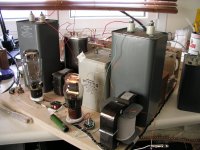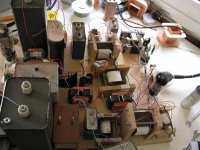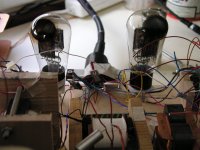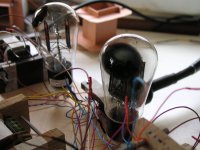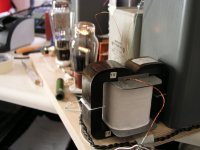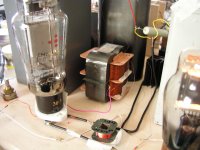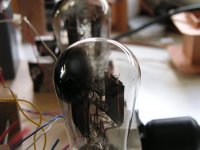Hi folks!
I decided to share with you my last project, to build a power amplifier around the american 801A tube manufactured by RCA.
The amp is a two-stage design with directly heated triodes throughout. The power tube gives around 4 watts of A1 power at full bias but is a small giant, as it can be driver further than 0V Vg, so you need a good driver to squeeze A2 power.
The driver is Emission Labs 30A, with a gain of 32x and good plate impedance to drive 801A in Class A2.
All power supplies include only vintage oil capacitors, there is nowhere any electrolytic or modern "Hi-End" cap, their sound is rather mediocre against those beasts. The only electrolytic found is on the filaments of 30A, current source driven, where 801A is AC heated, with only 14mV or ripple on the speaker.
The tubes are power by double Pi filters, rectified with my favorites RGN4004 by Telefunken, quite possibly the best rectifiers ever made!
All power supply transformers, rectifier filament transformers, power supply chokes, interstage & output transformers are wound by myself exclusively, signal transformers are made of 0.1mm CRGO c cores. Even the cathode resistor of 30A is bifilar wound non inductive, with monocrystalline enameled copper wire. Only C Core transformers are used, there is nowhere any crap E-I iron.
I'm now fine tuning the sound of the amp with different brands of oil capacitors. This amp will drive a pair of 8" Telefunken field coil loudspeakers, powered by one Telefunken RGN4004 each.
I hope this project will give really good sound. I will be posting newer pictures as the project goes on.
I decided to share with you my last project, to build a power amplifier around the american 801A tube manufactured by RCA.
The amp is a two-stage design with directly heated triodes throughout. The power tube gives around 4 watts of A1 power at full bias but is a small giant, as it can be driver further than 0V Vg, so you need a good driver to squeeze A2 power.
The driver is Emission Labs 30A, with a gain of 32x and good plate impedance to drive 801A in Class A2.
All power supplies include only vintage oil capacitors, there is nowhere any electrolytic or modern "Hi-End" cap, their sound is rather mediocre against those beasts. The only electrolytic found is on the filaments of 30A, current source driven, where 801A is AC heated, with only 14mV or ripple on the speaker.
The tubes are power by double Pi filters, rectified with my favorites RGN4004 by Telefunken, quite possibly the best rectifiers ever made!
All power supply transformers, rectifier filament transformers, power supply chokes, interstage & output transformers are wound by myself exclusively, signal transformers are made of 0.1mm CRGO c cores. Even the cathode resistor of 30A is bifilar wound non inductive, with monocrystalline enameled copper wire. Only C Core transformers are used, there is nowhere any crap E-I iron.
I'm now fine tuning the sound of the amp with different brands of oil capacitors. This amp will drive a pair of 8" Telefunken field coil loudspeakers, powered by one Telefunken RGN4004 each.
I hope this project will give really good sound. I will be posting newer pictures as the project goes on.
Attachments
Hi!
Wow! Impressive, with all those DIY transformers. The 801A is my favorite tube!
I agree with Gluca, DC fils on the 801A might be wirth trying. Toss the curenst source fil supply and go all passive LCL. Since you can wind your iron yourself, give it a try.
I plan some new 801A amps in the near future too. I plan to use a driver which is switchable between 26 and 801A.
Step up input transformer to get enough gain
Best regards
Thomas
Wow! Impressive, with all those DIY transformers. The 801A is my favorite tube!
I agree with Gluca, DC fils on the 801A might be wirth trying. Toss the curenst source fil supply and go all passive LCL. Since you can wind your iron yourself, give it a try.
I plan some new 801A amps in the near future too. I plan to use a driver which is switchable between 26 and 801A.
Step up input transformer to get enough gain
Best regards
Thomas
Thanks
Thank you very much for your kind replies.
This project is based on some ideas expressed through the Sakuma System approach. Transformer coupling, AC heating on the last stage and self-bias scheme. I have experimented and found that Mr. Sakuma has a very interesting approach, at least to my ears I have not yet listened to anything better. AC heating of the last stage is best to my ears, 14mV is not that high but for speakers less than 97-98 dBs it is good. I can lower it further but this is going to be tried later on.
I have gained adequate experience during the last years in the field of transformers winding, so I decided to finish up this amp. I have tried several transformers with mixed results, from mediocre to good, but not exceptional. I know that there exist some old Tango designs originating back from the 80's, they are considered to be the best ones around. These are all hand wound by myself and are fine tuned to the maximum degree for this design. OPT is a rather big load for 801A (16.3k) and the output power can be raised further, the Anode-Cathode voltage is only 530 Volts but the current is raised to 37-38 mA through one 1kOhm cathode resistor. All these are done for maximum sound quality and not maximum power.
The passive CLC solution is something I would like to try on 30A filaments, but I am expecting something better and something worse. To my ears, nothing beats AC heating on the last stage, if you can tolerate or manage the slightly increased output hum. The diodes quality affect the sound of the 30A driver, I currently use discontinued GaAs diodes with very good results, but have my old selenium diodes handy for my next listening session.
What I have learned from this project is that the 'tone' of each capacitor is of great importance, I could say unexpectedly high importance. All power supply caps do not have the same sonic signature, so far I have mixed american and russian caps with better results, but have not yet finished.
This is the starting point of this project. When the amp is finished, I will disconnect the output stage and mount my beloved Telefunken RS241 triodes. Tubes are pretty interchangeable, different filament voltage/current, different biasing but same OPT. I have some dozens spread around and would like to compare their sound against 801A. And the last step is replacing RS241 with RS237, the king of all triodes. We'll see, I have much distance to cover till then.
Vinylsavor, have you experimented with passive CLC filament supply? I guess I will need a hum balance pot on the driver and it is quite difficult to find a low value carbon film, as the cathode resistor is only 100 Ohms of maximum attainable quality, remember the resistor is DIY bifillar wound with monocrystalline copper! If I replace a great part of this value with crap wire wound pots, the sound quality will deteriorate too much! Do you have an idea here?
Thanks again for your kind comments. I will be back soon...
P. Avgeris
Thank you very much for your kind replies.
This project is based on some ideas expressed through the Sakuma System approach. Transformer coupling, AC heating on the last stage and self-bias scheme. I have experimented and found that Mr. Sakuma has a very interesting approach, at least to my ears I have not yet listened to anything better. AC heating of the last stage is best to my ears, 14mV is not that high but for speakers less than 97-98 dBs it is good. I can lower it further but this is going to be tried later on.
I have gained adequate experience during the last years in the field of transformers winding, so I decided to finish up this amp. I have tried several transformers with mixed results, from mediocre to good, but not exceptional. I know that there exist some old Tango designs originating back from the 80's, they are considered to be the best ones around. These are all hand wound by myself and are fine tuned to the maximum degree for this design. OPT is a rather big load for 801A (16.3k) and the output power can be raised further, the Anode-Cathode voltage is only 530 Volts but the current is raised to 37-38 mA through one 1kOhm cathode resistor. All these are done for maximum sound quality and not maximum power.
The passive CLC solution is something I would like to try on 30A filaments, but I am expecting something better and something worse. To my ears, nothing beats AC heating on the last stage, if you can tolerate or manage the slightly increased output hum. The diodes quality affect the sound of the 30A driver, I currently use discontinued GaAs diodes with very good results, but have my old selenium diodes handy for my next listening session.
What I have learned from this project is that the 'tone' of each capacitor is of great importance, I could say unexpectedly high importance. All power supply caps do not have the same sonic signature, so far I have mixed american and russian caps with better results, but have not yet finished.
This is the starting point of this project. When the amp is finished, I will disconnect the output stage and mount my beloved Telefunken RS241 triodes. Tubes are pretty interchangeable, different filament voltage/current, different biasing but same OPT. I have some dozens spread around and would like to compare their sound against 801A. And the last step is replacing RS241 with RS237, the king of all triodes. We'll see, I have much distance to cover till then.
Vinylsavor, have you experimented with passive CLC filament supply? I guess I will need a hum balance pot on the driver and it is quite difficult to find a low value carbon film, as the cathode resistor is only 100 Ohms of maximum attainable quality, remember the resistor is DIY bifillar wound with monocrystalline copper! If I replace a great part of this value with crap wire wound pots, the sound quality will deteriorate too much! Do you have an idea here?
Thanks again for your kind comments. I will be back soon...
P. Avgeris
801A
Come on Vinylsavor, you live in Germany and your favorite tube is 801A and not Telefunken RS241??? That's not possible!!!
That's not possible!!!
This is something I would really like to do, passive CLC on driver, but DC on 801A is out of my interest for the time being.
That's very interesting, a 10-10 power amp (801-801 equivalent) I have seen an amp some years ago, done by a crazy japanese DIYer, all with crazy transformers, it was very interesting but cannot find the URL.
Forget step up transformer on input if you need a gain of more than 3x. I have huge experience there... I have wound many really good MC step up trannies with exceptional bandwidth & sound and insane ratios of 50x and 60x. The impedance mismatch if the gain is greater than 3x is evident, sound is compressed and boring. Remember if gain is 3x the impedance is raised 9x. On the other hand, if you need a gain of 2x-3x on the input, input transformer is the best solution bar none, an additional active stage is much worse there. This 801A amp would like to have a gain of 2x on input but this will be done through an active stage that is going to be eliminated from the source.
Thank you for your comment!
Hi!
Wow! Impressive, with all those DIY transformers. The 801A is my favorite tube!
Come on Vinylsavor, you live in Germany and your favorite tube is 801A and not Telefunken RS241???
I agree with Gluca, DC fils on the 801A might be wirth trying. Toss the curent source fil supply and go all passive LCL. Since you can wind your iron yourself, give it a try.
This is something I would really like to do, passive CLC on driver, but DC on 801A is out of my interest for the time being.
I plan some new 801A amps in the near future too. I plan to use a driver which is switchable between 26 and 801A.
That's very interesting, a 10-10 power amp (801-801 equivalent) I have seen an amp some years ago, done by a crazy japanese DIYer, all with crazy transformers, it was very interesting but cannot find the URL.
Step up input transformer to get enough gain
Forget step up transformer on input if you need a gain of more than 3x. I have huge experience there... I have wound many really good MC step up trannies with exceptional bandwidth & sound and insane ratios of 50x and 60x. The impedance mismatch if the gain is greater than 3x is evident, sound is compressed and boring. Remember if gain is 3x the impedance is raised 9x. On the other hand, if you need a gain of 2x-3x on the input, input transformer is the best solution bar none, an additional active stage is much worse there. This 801A amp would like to have a gain of 2x on input but this will be done through an active stage that is going to be eliminated from the source.
Thank you for your comment!
Petavgeris ... LCL for filaments.
Gluca, you have made me losing my sleep! CLC is what I would like to evaluate on the driver, but I'm afraid of the hum. Wouldn't need a hum balance pot there?
I will wind a choke tomorrow and will let you know of my impressions. I am very curious indeed!
Thank you for your comment.
Best regards,
Peter
Peter
what you really want to try is a LCL. the choke input filter will avoid all the hi-freq pollution a C input filter spreads all over and the last choke will present a high impedance to the filament insulating the PSU. now, a further step would be using a solid state regulator (after the LC filter): I am pretty darn happy with Rod Coleman's solution (google here on Diyaudio).
A few test here
ClariSonus - Clear and enjoyable sound Amplification
Since I tried LCL (with a further CL as required in preamp/drivers) I converted all my amps and preamps (mainly based on big thoriated tungsten filament tubes).
i am not using anymore interstages, my last amps are direct coupled (and fixed bias) and that removes a very critical and expensive item from my shopping list.
Gianluca
what you really want to try is a LCL. the choke input filter will avoid all the hi-freq pollution a C input filter spreads all over and the last choke will present a high impedance to the filament insulating the PSU. now, a further step would be using a solid state regulator (after the LC filter): I am pretty darn happy with Rod Coleman's solution (google here on Diyaudio).
A few test here
ClariSonus - Clear and enjoyable sound Amplification
Since I tried LCL (with a further CL as required in preamp/drivers) I converted all my amps and preamps (mainly based on big thoriated tungsten filament tubes).
i am not using anymore interstages, my last amps are direct coupled (and fixed bias) and that removes a very critical and expensive item from my shopping list.
Gianluca
Hi Peter,
as Gluca pointed out LCL is the way to go on filaments not CLC. In fact LCL sounds better than AC heating! Make sure to have high enough inductance (several 100 mHy). You will not need a hum pot if you get the DC very clean.
No more intermodulation artufacts from AC filaments, sounds way better to me!
With regard to input transformers: You are right of course about the impedance raise. Of course I drive such power amps with input transformer with a preamp with very low output impedance which is adequate for the job!
Have you tried the ultrapath approach? You will find circuits with ultrapath caps on my blog.
best regards
Thomas
as Gluca pointed out LCL is the way to go on filaments not CLC. In fact LCL sounds better than AC heating! Make sure to have high enough inductance (several 100 mHy). You will not need a hum pot if you get the DC very clean.
No more intermodulation artufacts from AC filaments, sounds way better to me!
With regard to input transformers: You are right of course about the impedance raise. Of course I drive such power amps with input transformer with a preamp with very low output impedance which is adequate for the job!
Have you tried the ultrapath approach? You will find circuits with ultrapath caps on my blog.
best regards
Thomas
Thanks
Hello and thank you for your invaluable help!
I was thinking of using a dual current source on both ends of filament connection, but the idea of LCL has not passed through my mind.
I assume that if I wind the chokes as 'common mode' and use one half on each filament end (last choke), then the last choke is a good approach to the theoretical current source, so there is no anode current passed through the PS. It is very clever. This is a dual current source made passive throughout!
Hopefully LCL would be adequate for 801A, where LCLCL would be unavoidable on driver for reduced hum.
Guys, you have put me to do a lot of homework. I need some days to finish up but it is very interesting definately!
Hello and thank you for your invaluable help!
I was thinking of using a dual current source on both ends of filament connection, but the idea of LCL has not passed through my mind.
I assume that if I wind the chokes as 'common mode' and use one half on each filament end (last choke), then the last choke is a good approach to the theoretical current source, so there is no anode current passed through the PS. It is very clever. This is a dual current source made passive throughout!
Hopefully LCL would be adequate for 801A, where LCLCL would be unavoidable on driver for reduced hum.
Guys, you have put me to do a lot of homework. I need some days to finish up but it is very interesting definately!
Hi Peter,
also for the driver LCL is sufficent, if the inductance is high enough.
I used 801 drivers in this 45 amp with LCL fils:
VinylSavor: Making of an 45 / 2A3 amplifier
PSU:
VinylSavor: Making of a 45 / 2A3 amplifier, Part 2 - The PSU
The fil chokes are 0,4Hy with 30.000uF between them.
With such inductances LCL is even sufficient in preamps:
VinylSavor: More photos of the 801A / 26 linestage
Here I used 0.4Hy - 40.000uF - 0.4Hy
No hum. If it is good enough in a preamp it will be more than adequate as a driver in a power amp.
Best regards
Thomas
also for the driver LCL is sufficent, if the inductance is high enough.
I used 801 drivers in this 45 amp with LCL fils:
VinylSavor: Making of an 45 / 2A3 amplifier
PSU:
VinylSavor: Making of a 45 / 2A3 amplifier, Part 2 - The PSU
The fil chokes are 0,4Hy with 30.000uF between them.
With such inductances LCL is even sufficient in preamps:
VinylSavor: More photos of the 801A / 26 linestage
Here I used 0.4Hy - 40.000uF - 0.4Hy
No hum. If it is good enough in a preamp it will be more than adequate as a driver in a power amp.
Best regards
Thomas
Hi Gianluca,
I use these Lundahls:
http://lundahl.se/pdfs/datash/2733.pdf
series connection.
In the meantime I also have them available gapped for 0.5Hy/1.25A (for 801A) and 0.7Hy/1A (for 26)
Best regards
Thomas
I use these Lundahls:
http://lundahl.se/pdfs/datash/2733.pdf
series connection.
In the meantime I also have them available gapped for 0.5Hy/1.25A (for 801A) and 0.7Hy/1A (for 26)
Best regards
Thomas
This 45/2A3 should be a really good amp. I wish I listened to it some time...
801A and 30A draw ~1.3 Amperes of current, so the filament chokes should not be that small... I need to make some calculations before winding, but for good results I think that I will not end up with less than 1 sq. inch of cross sectional area or iron.
On your schematics, I have seen that you prefer choke input filter. I have experimented a lot, but the sound is not that good to my ears. Actually I 've never had best results with choke input filter, although I cannot find a theoretical approach for this...
Let's see... I will push the two filament chokes to the limits so as to see what I will benefit of. The idea of passive dual current source on filaments is intiguing!
Thanks for the info.
Peter.
801A and 30A draw ~1.3 Amperes of current, so the filament chokes should not be that small... I need to make some calculations before winding, but for good results I think that I will not end up with less than 1 sq. inch of cross sectional area or iron.
On your schematics, I have seen that you prefer choke input filter. I have experimented a lot, but the sound is not that good to my ears. Actually I 've never had best results with choke input filter, although I cannot find a theoretical approach for this...
Let's see... I will push the two filament chokes to the limits so as to see what I will benefit of. The idea of passive dual current source on filaments is intiguing!
Thanks for the info.
Peter.
Hi Peter,
yes that 45 amp sounds quite nice. It is among the best amps I ever built.
Surprising that you don't like choke input. Normally this is a no brainer. Choke input can be tricky though. Critical current needs to be ensured. Ultimately I prefer the bridge rectifer configuration with 4 diodes with choke input.
Best regards
Thomas
yes that 45 amp sounds quite nice. It is among the best amps I ever built.
Surprising that you don't like choke input. Normally this is a no brainer. Choke input can be tricky though. Critical current needs to be ensured. Ultimately I prefer the bridge rectifer configuration with 4 diodes with choke input.
Best regards
Thomas
Hi Peter,
yes that 45 amp sounds quite nice. It is among the best amps I ever built.
Surprising that you don't like choke input. Normally this is a no brainer.
Thomas
Hello Thomas!
Just by watching the pics I realised that this amp cannot be a mediocre amp. Now you come and verify my assumption and write that it is among the very best! You see, I have the experience to stick on the good things...
Now, regarding choke input, sorry, but I won't take it... I have experimented a lot and a lot and a lot, but to my ears it sounds as a disaster! Believe it or not, it is not good sounding, speaking of tubes rectification. Whenever I go down to less than 2 uF of capacitance, the result starts to get poor.
Let me explain: with low capacitance, consider the music to be wooly, piano notes are perceived as losing great part of their lustre. With more capacitance, they are sparkling, glowing! I cannot describe this in a better way!
I have used several rectifiers, yesterday I increased the capacitance of RGN4004 and the sound improved much!
Try it and you will see...
hello there. can you pelase tell me where do you buy your c-cores from?
Nice project bdw. tons of iron
Visit Magnetic Cores
You will find whatever you will ever need!
Good luck!
- Status
- This old topic is closed. If you want to reopen this topic, contact a moderator using the "Report Post" button.
- Home
- Amplifiers
- Tubes / Valves
- My little 801A power amplifier
